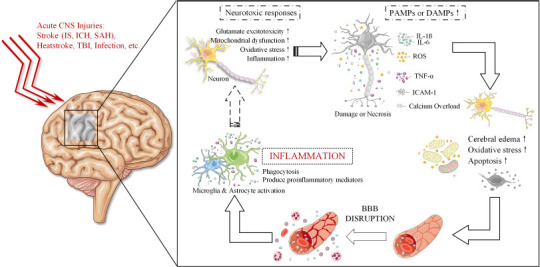Figure 1.

The vicious circle of neuroinflammation after acute central nervous system injury.
After acute CNS injury, neurons are deprived of oxygen and energy, which triggers a series of chain reactions, such as glutamate excitotoxicity, mitochondrial dysfunction, oxidative stress, and inflammation, leading to neuronal damage and necrosis. This leads to calcium overload and the release of acute inflammatory mediators such as TNF-α, IL-1β, IL-6, ROS, and ICAM-1, exacerbating cerebral edema, oxidative stress and apoptosis, leading to disruption of the BBB and increasing the inflammatory response in the brain. BBB: Blood-brain barrier; CNS: central nervous system; DAMPs: danger-associated molecular patterns; ICAM-1: intercellular adhesion molecule-1; ICH: intracerebral hemorrhage; IL: interleukin; IS: ischemic stroke; PAMPs: pathogen-associated molecular patterns; ROS: reactive oxygen species; SAH: subarachnoid hemorrhage; TBI: traumatic brain injury; TNF-α: tumor necrosis factor-α.
